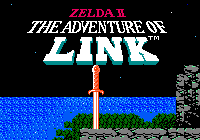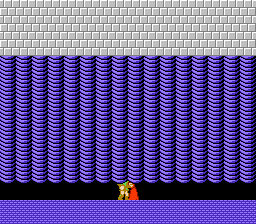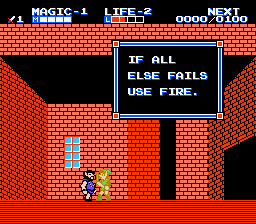 |
The Legend of Zelda II: The Adventure of Link - Retroview |
 |
I Am Error.
By: Andrew Long
| Review Breakdown |
| Battle System |
7 |
| Interface |
7 |
| Music/Sound |
5 |
| Originality |
8 |
| Plot |
3 |
| Localization |
2 |
| Replay Value |
10 |
| Visuals |
4 |
| Difficulty |
Medium |
| Time to Complete |
3-5 hours
|
|
| Overall |
 |
| Criteria
|

|
| |
Nintendo's relative dominance of the video game market during the 80s was
sealed by the fact they also had excellent first-party support for their
system, as evidenced by series such as the Super Mario Brothers franchise
and The Legend of Zelda games, both of which persist to this day. The
Legend of Zelda in particular developed a devoted following based on the
strengths of the first two NES titles. The first game was a tile-based
dungeon crawler, lacking in complexity but rich in gameplay. The second
game, on the other hand, was radically different. The Adventures of Link
was an action-RPG at heart, featuring fields, forests, caves, and castles
for its hero to jump, slash, and sometimes fly his way through. The result
was a slightly less cohesive game than its predecessor, but one that is
nonetheless enjoyable to this day.
The Legend of Zelda II picks up eight years following
the events of the original game. Link has grown into a strapping young
lad who now requires a sprite at least twice the size of his eight-year
old self. This new and bigger hero comes equipped with his requisite sword
and shield. Link also has a bone to pick, in this case with an evil magician
who is trying to restore our hero's archnemesis, Ganon, to power in Hyrule.
To this end, the wizard has rendered the princess comatose and stolen
a triforce or two, holing up in a palace surrounded by an impressive field
of lava. How this enables him to bring back Ganon is anyone's guess, but
the presence of such a maleficent force in the middle of nowhere, combined
with the slumbering princess, is evidently sufficient cause for Link to
tear across Hyrule's two continents in search of justice (and presumably,
the favour of princess Zelda once she wakes up.)
Zelda II features an overworld map with a number of dungeons, caves,
fields, towns and forests for Link to become entangled in. These altercations
begin one of two ways: either Link enters an area on the map, hidden or
plainly visible, or he is attacked by the roving monsters that infest
the landscape. There are three types of enemies on this screen: difficult,
represented by cavorting miniature Ganons, easy, represented by little
slimes (known, for whatever reason, as Bits and Bots in the game,) and
fairies, which restore Link's life if he catches them. The first two types
of encounters (as well as entry into caves, palaces, and even the occasional
town) result in combat scenes, which takes place wherever Link happens
to be (except on the road, which evidently serves as some sort of anathema
to the monsters.) Link is always at the ready with his sword and shield,
and, when at full life, possesses the ability to throw his sword. Link's
throwing speed has improved from "Puet-chuwet!" to "Choing!"
in the eight years between games, but as in the original game, the sole
advantage to thrown swords is distance. In fact, some of Zelda II's armoured
enemies cannot be damaged by this mode of attack. Link's shield is similarly
less than functional, serving only to block rocks on its own, and a few
other things with the help of magic spells.

|
| She likes them young |
|
Because Link's basic modes of attack don't cut it, Nintendo has thoughfully
included eight spells to help Link on his way. Anyone old enough to remember
the eighties might remember a Nintendo commercial with a guy dressed in
tights hopping around in some sort of sandy chamber, bowing before a bearded
man who says "I cannot help you," among other things. There
are eight of these bearded men, and gaining access to each can be as simple
as walking in their front door, or as annoyingly complicated as rescuing
their child from half a world away and returning it to safety. The spells
are also complemented by two special swordstrokes which can be obtained
by performing a variety of acrobatics, not the least of which includes
Link's killer Santa Claus impression. Yes, there's a chimney somewhere
that needs going down, because the up thrust and down thrust, as they're
called, are indispensable, and make the game much easier to complete.
On the whole, the combat system is fairly well thought out, and surprisingly
enjoyable, despite the relatively few options for upgrade that are available.
Attack levels are gained through obtaining experience points, and are
the only other chance for advancement, aside from the spells and sword
thrusts. There are also Heart Containers and magic bottles, which increase
maximum life and magic. Finally, every sixth enemy drops either a magic
refill or 'P-Bag'. P-Bags really just include experience points, but the instruction
book piously maintains that they can "contain monsters, tool".
Regardless, the economy of this system is ingenious; points are distributed
such that they take much of the game to obtain, and magic is a limited
resource. If magic is used unwisely, it almost invariably results in a
succecssion of P-Bags being dropped, as opposed to the precious magic
refill bottles. Players must thus learn to be judicious about their use
of magic, and what seems to be a very simple system is quite diverse in
practice.
Diversity would perhaps be more welcome on the aural
side of the game. While few NES games included more than a bare minimum
of music, there are only seven distinct pieces in this game, one of these
being the title theme. That music which is there, however, is decent.
The map theme is a new rendition of the classic Zelda theme, and the palace
theme in particular is a very complex song, at least by NES standards.
Regrettably, other music in the game tends to be repetitive; battle music
is roughly twenty seconds long and fairly uniform throughout that twenty
seconds, and the final palace theme, as well as the music in the game's
towns, can't help but stir up the image of Nintendo's square and triangle
wave sound channels suffering from a stuffy nose. As for the sound effects?
Well, they're about average, with some being annoying, some being acceptable.
Nothing about the sound in this game is particularly remarkable, in the
end.

|
| Inside the house of ill repute |
|
For a sequel, Zelda II strives admirably to be new and different.
While it does retain many elements of the previous game in the series,
the overall style of the game, coupled with a new battle system and even
a different visual style, make this game unique in the Zelda series. Certainly,
there are many elements retained from the original, but at no point does
this game descend to the level of homogeny found in other series such
as Mega Man. This is one area in which Nintendo should definitely be lauded;
their first party efforts for the NES showed a great desire to innovate
and change, and no two titles in either of their flagship series were
ever the same.
Well, almost no two elements. The storyline, while wrapped in
a thinly veiled chunk of evil wizard, is mostly the same as the first
Legend of Zelda title. Link still has to recover a damsel in distress,
and this is still achieved through collecting various things from here
and there. The only difference is the distinctly alien cast that everything
has. This is something that is fairly difficult to explain; while the
first Legend of Zelda made Hyrule feel somehow familiar, this game gives
the land an exotic air, which draws its strength due to everything from
the visual style to the naming of locations and the choice of characters.
Even the different musical style creates a different atmosphere. That
said, the plot is still rudimentary at best.
Also rudimentary is the pathetic translation effort given the game.
While dialogue by and large wasn't necessary, everything was squeezed
so that it could fit into a text box which could contain at most three
lines of text. This does not make for particularly stirring dialogue,
and while this was still an era in which plot had to be sacrificed in
deference to storage space, there are some truly cringe-inducing compressions
of text as words such as "and, the, as, if" get shunted aside
in favour of incomprehensibility. Just because a word is there doesn't
mean it makes sense, and on top of that, there are some very questionable
choices for names, such as the infamous Error of Ruto, as well as a few
typos in the instruction manual (where the P-Bags that "contain monsters
tool" originate). All in all, much more could have been done to ensure
this game was a little more comprehensible.

|
| Link gets some pointers on the finer side of relationships |
|
Fortunately, the main point of this game isn't the
story, or what they're naming people in Ruto these days, it's the gameplay,
and that's present in spades. The game is a great deal of fun, and it's
actually possible to finish it and then want to play it some more, even
though it's relatively short. Though the game isn't particularly challenging,
neither is it easy, and the level of challenge is just right to make it
instantly addictive. So addictive, in fact, that it can still be entertaining,
some thirteen years after its release. This, more than anything, is why
this game deserves recognition as being more than just an average sidescroller.
Lamentably, there are many average sidescrollers which look better than
Zelda II. The graphics aren't bad, per se; they just look somehow out
of place, and have a slightly rushed air about them. Some of the game's
plant life looks remarkably similar to visual effects that can be observed
when old NES units start acting up, and perhaps it is this effect that
makes them somehow unsatisfying. Character sprites are also very spare
in terms of details, and even "back in the day," this game just
wasn't considered to be that great in the visual department. Once again,
it's nothing specific; perhaps it's just the combination of ugly plant
life with a palace that looks rather as if it's been constructed out of
bathroom tiles that leaves me vaguely unsatisfied with the look of this
game.
In sum, then, Zelda II may have its flaws, but it's definitely an enjoyable
game to play through. Games in the NES era are generally more focused
on gameplay than story anyhow, and so it is with this title. In the end,
its strong gameplay and addictive battle system more than make up for
its shaky technical attributes and somewhat limited plot to carve its
place in the annals of RPG history.
|










